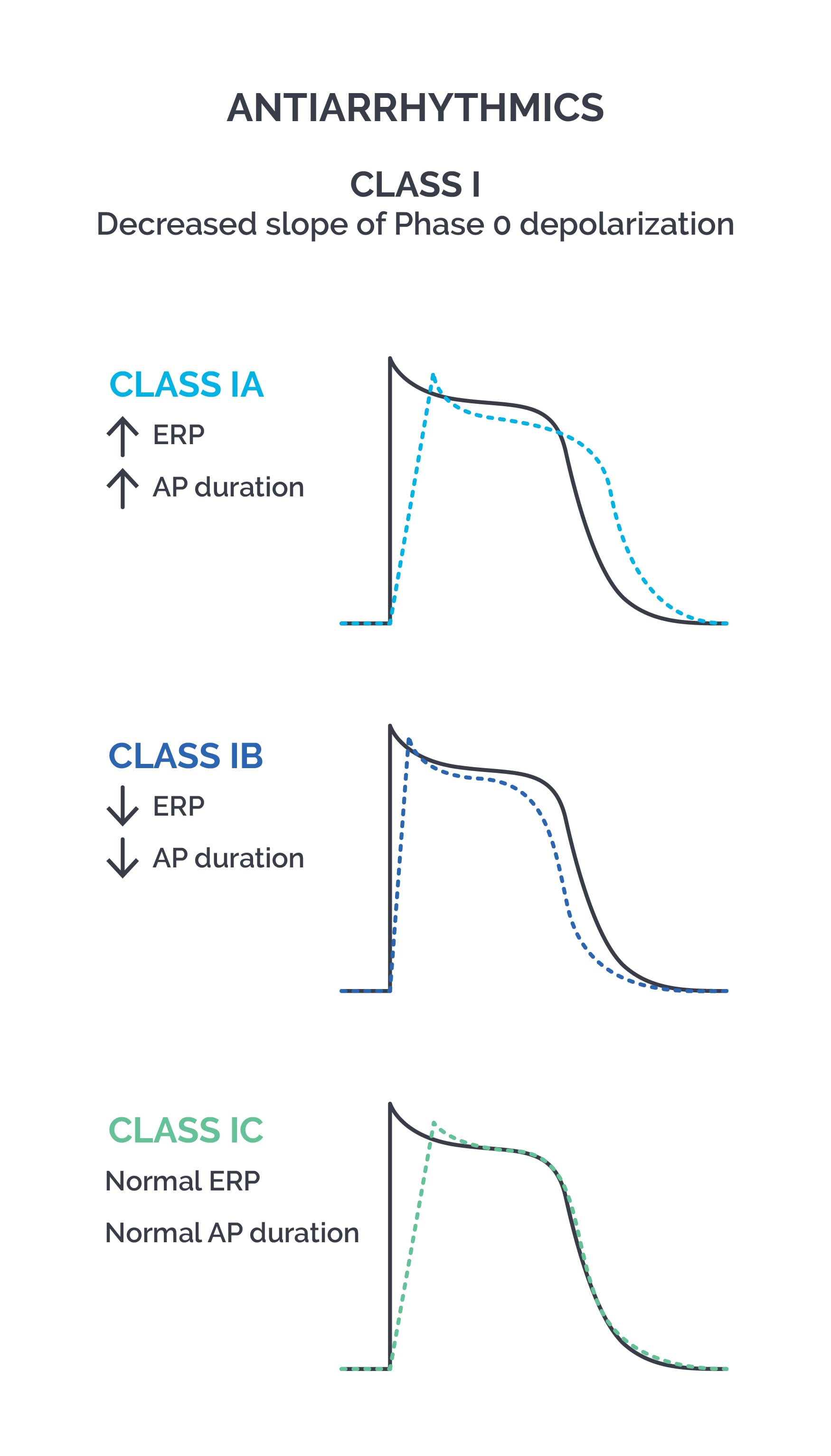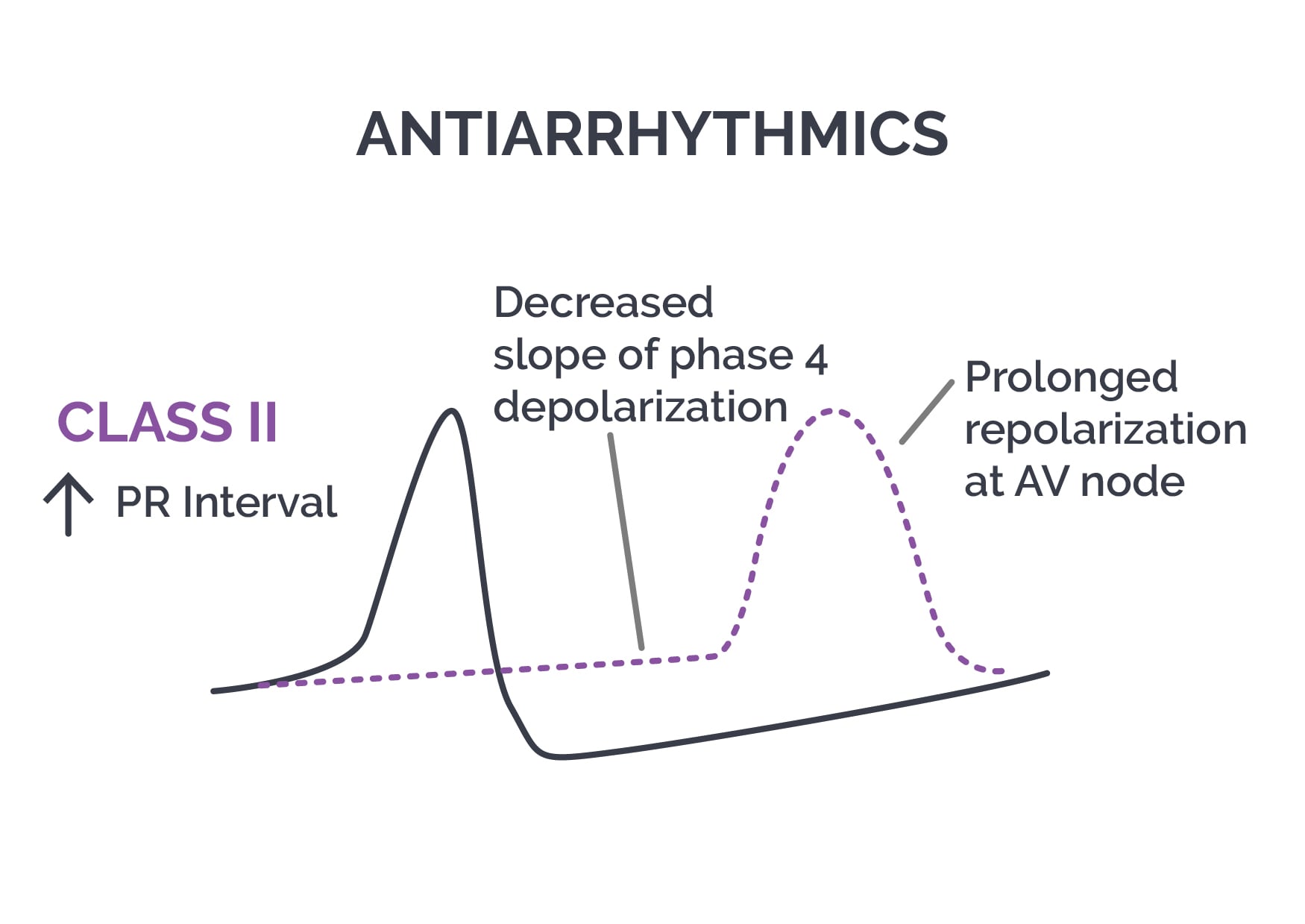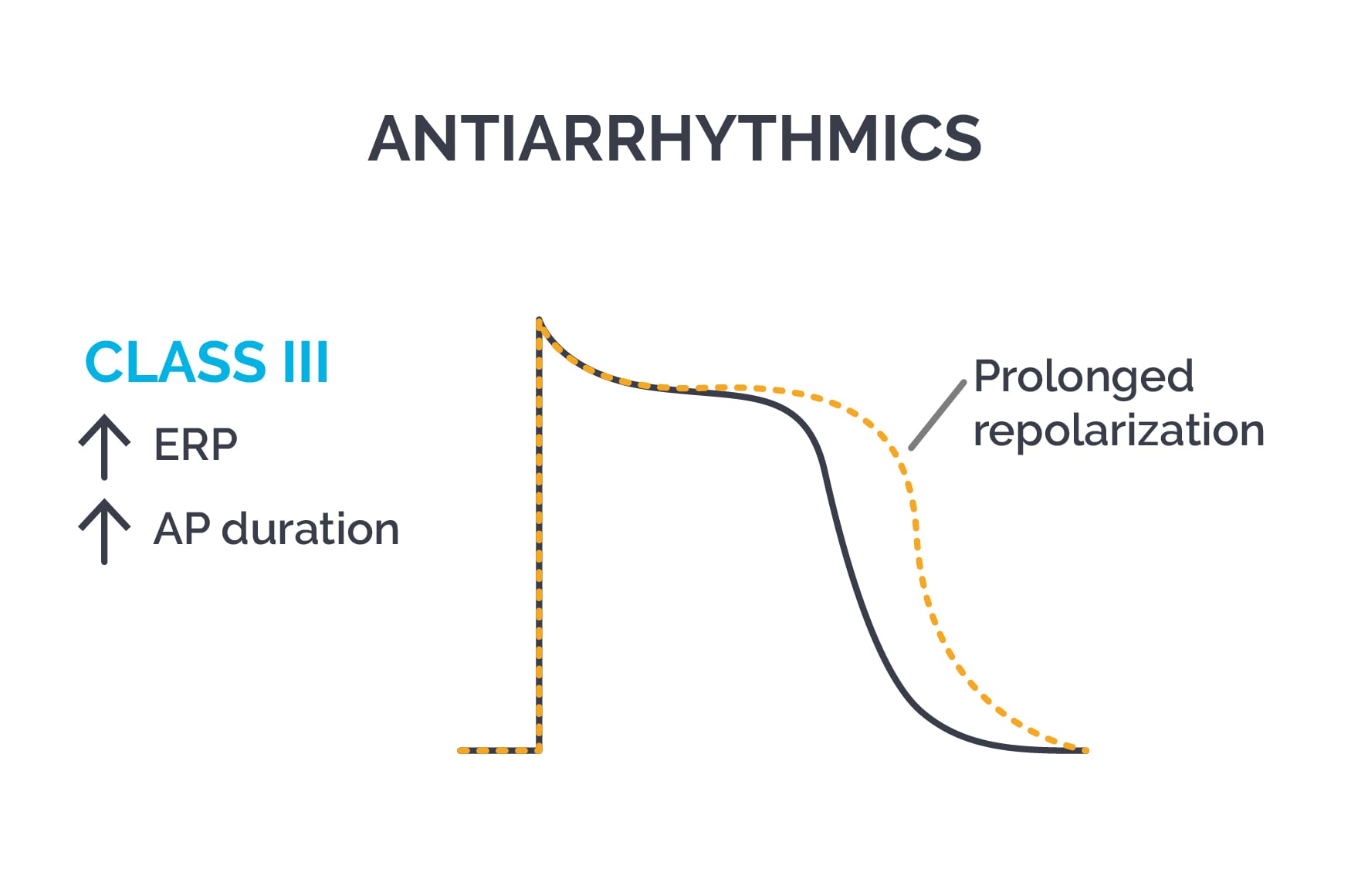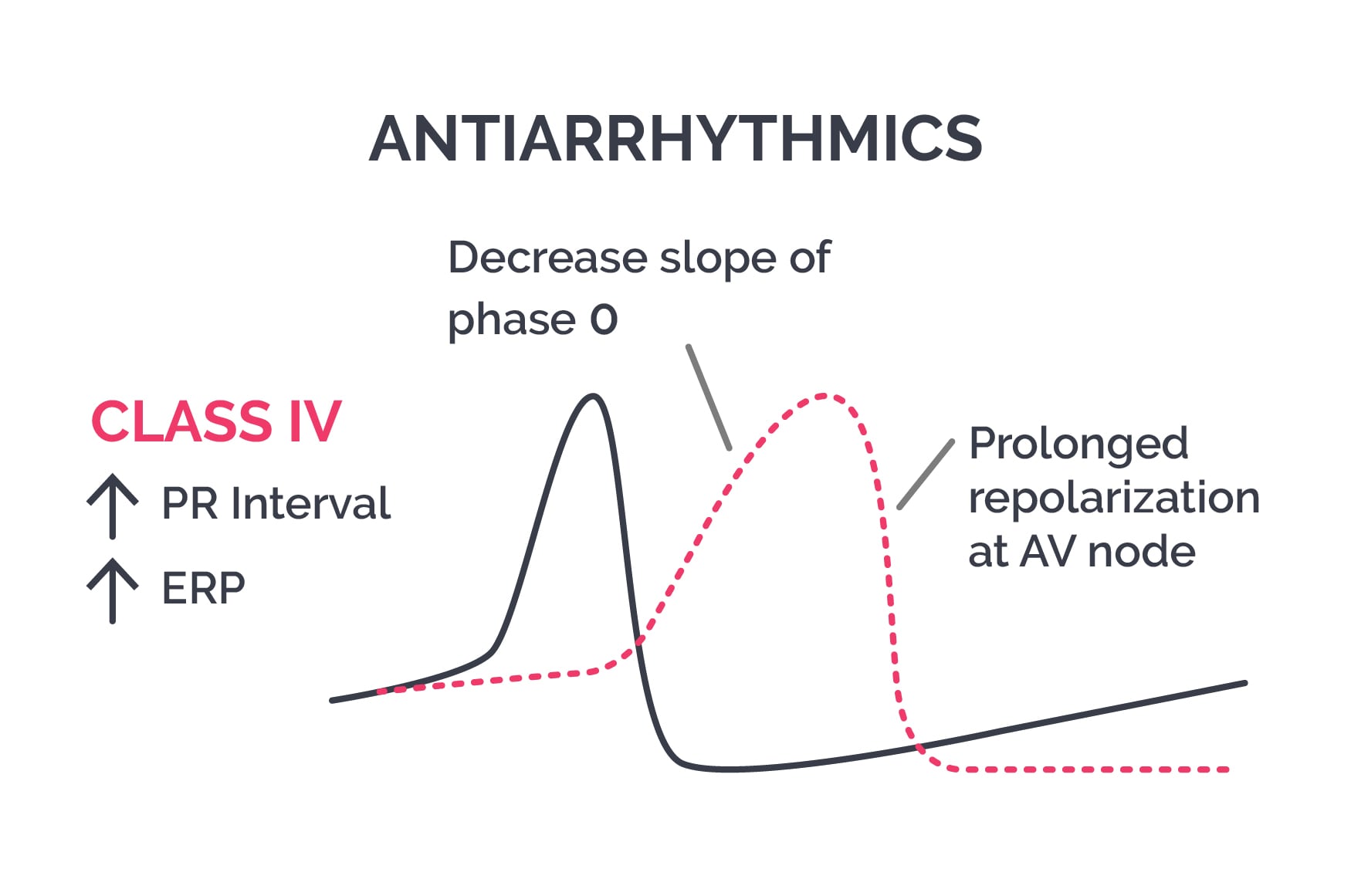They are divided into four classes depending on the mechanism of action as follows:
i) Class I or Sodium channel blockers: They block fast sodium channels leading to a decrease in the slope of phase 0 of the cardiac action potential, as well as decrease in the amplitude of the action potential, decrease in conduction velocity, and block re-entry currents. They do not affect the nodal tissues.
Class IA increase the effective refractory period or ERP. This group includes quinidine, procainamide and disopyramide. Adverse effects include cinchonism or tinnitus, dizziness, blurred vision and headache with quinidine and lupus-like syndrome with procainamide. Quinidine may enhance digitalis toxicity and precipitate Torsades de pointes in long QT syndrome. Class IA drugs also have anticholinergic adverse effects.

Class IB decrease the effective refractory period. This group includes lidocaine, tocainide and mexiletine. Lidocaine and mexiletine have good efficacy in ischemic myocardium.
Class IC have no effect on the effective refractory period. This group includes flecainide, propafenone and moricizine.
ii) Class II or beta blockers: Antiarrhythmic activity is caused by beta 1 receptor blockade and sympatholytic activity with decreased heart rate and conduction velocity, inhibit SA node pacemaker activity, increase the duration of myocyte action potential and increasing ERP.

iii) Class III or potassium channel blockers: Block potassium channels, prolongs phase 3 repolarization, increase the duration of action potential and increase ERP. Increase QT interval. Effective in reentrant tachycardias. This class includes amiodarone, dronedarone, bretylium, sotalol, ibutilide and dofetilide. Amiodarone is used in ventricular tachycardia, ventricular fibrillation and atrial fibrillation. It has a long half life of up to 2 months and has Class I,II and IV effects also. Pulmonary fibrosis and thyroid imbalance are serious adverse effects of amiodarone. Class III drugs may precipitate torsades de pointes.

iv) Class IV or calcium channel blockers: They block L type calcium channels in nodal tissue especially AV node, decrease conduction velocity, prolong repolarization and decrease firing rates of aberrant pacemakers. Verapamil and diltiazem are used.

Patients with sinus tachycardia are treated with beta blockers or calcium channel blockers, when needed. In atrial flutter or fibrillation, ventricular rate is controlled with either digitalis, adenosine, Class IA, IC, II, III or IV drugs. All these drugs, except digitalis, are also helpful in SVT. Atropine can be used in AV block. Ventricular tachycardia is treated with class I,II or III drugs.
v) Miscellaneous antiarrhythmics
Adenosine: It is the breakdown product of ATP, formed by the action of the enzyme 5’ nucleotidase. It is a purine nucleoside and binds to purinergic receptors and has mainly two effects on the CVS - vasodilation and slowing down the heart rate and AV conduction. It has a half life of <10 seconds. Antiarrhythmic effect is by binding to Gi coupled A1 receptors, opening of K channels causing hyperpolarization, decreased cAMP, inhibition of L-type calcium channels, inhibition of pacemaker current with decrease in the slope of phase 4 of the pacemaker action potential. It causes AV block. Vasodilatory effect is due to binding the Gs coupled, type 2A adenosine receptor causing increase in cAMP, activation of K-atp channels, hyperpolarization of smooth muscle membrane, inhibition of myosin light chain kinase and decreased intracellular calcium leading to vasodilation.
Digitalis: It binds to and inhibits the Na/K ATPase pump. Related compounds include digoxin, digitoxin and ouabain. This pump moves 3 Na out of the cell and brings in 2 K ions. Hence, the Na/K ATPase pump is electrogenic and requires ATP. Digitalis inhibits the Na/K ATPase pump as a result of which the intracellular Na increases in the myocyte. This then leads to an accumulation of intracellular calcium via the Na-Ca exchanger system. More calcium is released from the sarcoplasmic reticulum, causing positive inotropy or force of contraction.
Digitalis has a narrow therapeutic index, hence plasma levels need to be monitored. Risk is increased as digitalis has a long half life. Certain drugs increase the toxicity of digoxin. These include quinidine (displaces digoxin from binding sites, decreases renal clearance), calcium channel blockers, NSAIDS, amiodarone and beta blockers. Toxicity is aggravated by hypokalemia as seen with diuretic therapy. Dose of digitalis needs to be decreased in renal failure. Hypokalemia, hypercalcemia and hypomagnesemia predispose to digoxin induced arrhythmias. Digitalis is contraindicated in WPW syndrome and AV block.
Digitalis toxicity presents with lethargy, fatigue, yellow halos, photophobia, blurred vision, nausea, vomiting, confusion, hallucinations, paresthesia, palpitations, bradycardia etc. ECG shows downsloping ST segment depression, frequent PVCs with ventricular bigeminy and trigeminy, sinus bradycardia, AV block, ventricular ectopics, slow AF, atrial tachycardia with 2:1 block, ventricular tachycardia etc. Treatment is with digoxin Fab fragments which bind to the drug, correction of hypokalemia or hyperkalemia, hemodialysis if needed and supportive therapy. In case of accidental or intentional ingestion of large doses of digitalis, gastric decontamination with activated charcoal is done within 6-8 hours after ingestion. Binding resins such as cholestyramine and colestipol decrease enterohepatic recycling of digitalis and enhance elimination.
Sign up for free to take 2 quiz questions on this topic